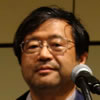Effectiveness of Artificial Gravity with Exercise on Spaceflight Deconditioning in Humans – Publicly Invited Research 2016-2017
- A02 Shinohara
- A02 Maekawa
- A02 Ohgami
- A02 Nishimura
- A02 Kawano
- A02 Iwase
- A02 Furuichi
- A02 Myung
- A02 Kitamura
| Research Subject | Effectiveness of Artificial Gravity with Exercise on Spaceflight Deconditioning in Humans |
|---|---|
| Research Group Leader |

|
| Research Group Members |
|
Changes that occur in the neurovestibular system, cardiovascular system, musculoskeletal system, hematological and immunological systems, and in bone metabolism during spaceflight become problems once the astronauts return to the 1G environment on Earth. This spaceflight deconditioning may be suppressed by countermeasures, but no single measure can cope with the deconditioning of all such systems. The present study aims to elucidate the cause of spaceflight deconditioning and set countermeasures with exercise under artificial gravity. Our findings may prove useful when proceeding to a base on the Moon or launching an expedition to Mars. For the analogue of microgravity, we used head-down bedrest or parabolic flight, and examined the effectiveness of combining artificial gravity produced by a centrifuge with ergometric or squatting exercises.

